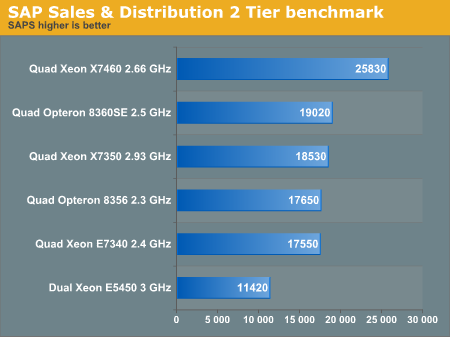Intel Xeon 7460: Six Cores to Bulldoze Opteron
by Johan De Gelas on September 23, 2008 12:00 AM EST- Posted in
- IT Computing
SAP SD
The SAP SD (Sales and Distribution, 2-tier internet configuration) benchmark is an extremely interesting benchmark as it is a real world client-server application. We decided to look at SAP's benchmark database. The results below are 2-tier benchmarks, so the database and the underlying OS can make a big difference. Unless we keep those parameters the same, we cannot compare the results. The results below all run on a Windows 2003 Enterprise Edition and MS SQL Server 2005 database (both 64-bit), and each "2-tier Sales & Distribution" benchmark was performed on SAP's "ERP release 2005".

In our previous server-oriented article, we summed up a rough profile of SAP S&D:
- Very parallel resulting in excellent scaling
- Low to medium IPC, mostly due to "branchy" code
- Not really limited by memory bandwidth
- Likes large caches
- Sensitive to Sync ("cache coherency") latency
AMD has held the performance crown in SAP S&D since the launch of the 8360SE at 2.5GHz, but the Intel six-core monster overpowers the latest quad-core Opteron. The huge cache, less cache coherency traffic between the sockets, and two extra cores make the new Xeon close to invincible. Even AMD's 45nm Opteron (Shanghai) will most likely not be able to outperform the Intel behemoth: the increase in L3 cache and small IPC improvements will probably not be able to negate the effect of two extra cores for Dunnington.
Until AMD starts shipping its 6-core products at the end of 2009, Intel will have a firm grip on the ERP and high-end database market. The SAP benchmark confirms that for this type of workload, the Xeon 74xx platform is close to unbeatable. However, we need to look at more than the high-end database market. What about virtualization?










34 Comments
View All Comments
JarredWalton - Tuesday, September 23, 2008 - link
Heh... that's why I love the current IBM commercials."How much will this save us?"
"It will reduce our power bills by up to 40%."
"How much did we spend on power?"
"Millions."
[Cue happy music....]
What they neglect to tell you is that in order to achieve the millions of dollars in energy savings, you'll need to spend billions on hardware upgrades first. They also don't tell you whether the new servers are even faster (it's presumed, but that may not be true). Even if your AC costs double the power bills for a server, you're still only looking at something like $800 per year per server, and the server upgrades cost about 20 times as much every three to five years.
Now, if reduced power requirements on new servers mean you can fit more into your current datacenter, thus avoiding costly expansion or remodeling, that can be a real benefit. There are certainly companies that look at density as the primary consideration. There's a lot more to it than just performance, power, and price. (Support and service comes to mind....)
Loknar - Wednesday, September 24, 2008 - link
Not sure what you mean: "reduced power requirements means you can fit more into your DC". You can fill your slots regardless of power, unless I'm missing something.Anyway I agree that power requirement is the last thing we consider when populating our servers. It's good to save the environment, that's all. I don't know about other companies, but for critical servers, we buy the most performing systems, with complete disregard of the price and power consumption; because the cost of DC rental, operation (say, a technician earns more than 2000$ per year, right?) and benefits of performance will outweigh everything. So we're so happy AMD and Intel have such a fruitful competition. (And any respectable IT company is not fooled by IBM's commercial! We only buy OEM (Dell in my case) for their fast 24-hour replacement part service and worry free feeling).
JarredWalton - Wednesday, September 24, 2008 - link
I mean that if your DC has a total power and cooling capacity of say 100,000W, you can "only" fit 2000 500W servers in there, or you could fit 4000 250W servers. If you're renting rack space, this isn't a concern - it's only a concern for the owners of the data center itself.I worked at a DC for a while for a huge corporation, and I often laughed (or cried) at some of their decisions. At one point the head IT people put in 20 new servers. Why? Because they wanted to! Two of those went into production after a couple months, and the remainder sat around waiting to be used - plugged in, using power, but doing no actual processing of any data. (They had to use up the budget, naturally. Never mind that the techs working at the DC only got a 3% raise and were earning less than $18 per hour; let's go spend $500K on new servers that we don't need!)